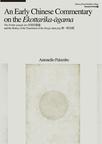An Early Chinese Commentary on the Ekottarika-āgama 《分別功德論》與《增一阿含經》譯經史考
2013
Dharma Drum Publishing Corp., Taiwan
Antonello Palumbo
无
This study reassesses an old problem in the history of Chinese Buddhism, the origins and nature of the Zengyi ahan jing 增一阿含經 (Taishō 125). It does so by a close investigation of the Chinese translation of the Ekottarika-āgama at the end of the fourth century and of its most important witness, the Fenbie gongde lun 分別功德論 (Taishō 1507). It is argued that the latter document, whose original title was Zengyi ahan jing shu 增一阿含經疏, should be seen as an unfinished commentary to the newly translated collection, produced within the original translation team (including Dao’an 道安, Zhu Fonian 竺佛念 and the Indo-Bactrian master Dharmananda) during the tumultuous end of the Qin秦 empire of Fu Jian苻堅in A.D. 385. This reconstruction yields further insights into the cultural origins of the Chinese Ekottarika-āgama, and its broader significance for the history of Buddhism.
Antonello Palumbo is Lecturer in Chinese Religions at the School of Oriental and African Studies, University of London
Contents
Series preface ix
Foreword xi
Acknowledgments xiii
Introduction 1
PART I. The Zengyi ahan jing 增一阿含經 (T.125)
CHAPTER ONE The translation of the Ekottarika-āgama 9
I. The initial redactions of the Zengyi ahan jing增一阿含經 (T.125), A.D. 384–385 9
I.1 The context: Dao’an 道安 and the translation group at Chang’an, A.D. 382–385 9
I.2 The translation of the Ekottarika-āgama and the different redactions of the Zengyi ahan jing 增一阿含經 (T.125), A.D. 384–385 36
II. The aftermath of the translation 49
II.1 The death of Dao’an 道安 and the dispersal of the Chang’an group 49
II.2 Saṃghadeva’s revision 65
II.3 Zhu Fonian 竺佛念 82
III. Four redactions, how many translations? 94
CHAPTER TWO Witnesses to the context and early re¬cep¬¬tion of the Zengyi ahan jing 增一阿含經 (T.125) 97
I. Before the translation 97
I.1 The narrative on the origin of the āgamas in the Parinirvāṇa sūtra (T.6) 99
I.2 Kumārajīva and the Ekottarika-āgama 105
II. Around the translation 108
II.1 The Zhuanji sanzang ji zazang zhuan 撰集三藏及雜藏傳 (T.2026) 108
II.2 The Fenbie gongde lun 分別功德論 (T.1507) 124
II.3 The manuscript S.797 (A.D. 406) 124
II.4 The miniature stūpas of Turfan and Liangzhou 涼州 (A.D. 426–435) 128
III. Early witnesses to the Zengyi ahan jing 增一阿含經 129
III.1 The Shijia pu 釋迦譜 (ca. A.D. 479–502) 129
III.2 The Fan fanyu 翻梵語 (ca. A.D. 502–512) 130
III.3 The Zengyi ahan jing 增一阿含經 parallels in the Taishō canon and the excerpts in the Jinglu yi¬xiang 經律異相 (ca. A.D. 517) 131
IV. The catalogues 145
V. Preliminary conclusions 154
PART II. The Fenbie gongde lun 分別功德論 (T.1507)
CHAPTER THREE The book in the catalogues 163
I. The Chu sanzang ji ji 出三藏記集 (ca. A.D. 515) 164
II. The Lidai sanbao ji 歷代三寶紀 (A.D. 598) 168
III. The Kaiyuan Shijiao lu 開元釋教錄 (A.D. 730) 169
CHAPTER FOUR Modern scholars 171
I. Jean Przyluski 171
II. Mochizuki Shinkō 望月信亨 172
III. Mori Sodō 森祖道 174
IV. Mizuno Kōgen 水野弘元 177
V. Other scholars 176
CHAPTER FIVE Internal evidence on the date and au¬thor¬-ship of the Fenbie gongde lun 分別功德論 (T.1507) 179
I. General features and contents of the commentary 180
II. The ‘foreign master/s’ (waiguo shi 外國師) and ‘that man’ (qi ren 其人) 185
III. The description of the Tripiṭaka and the hierarchy of the four āgamas 190
IV. The view of the vinaya 195
V. The authors’ notion of the origin of the Abhi¬dhar¬ma and the identification of Kātyāyanīputra with Mahā--Kātyāyana 205
VI. The relationship with the Zhuanji sanzang ji za¬zang zhuan 撰集三藏及雜藏傳 and the Mahāyānist layer 214
VII. The “small” ‘Greater Version’ (Dapin 大品) of the Prajnāpāramitā 230
VIII. Scriptural quotations 232
VIII.1 Da ai jing 大哀經 (Tathāgatamahākaruṇānirdeśa) 232
VIII.2 Weimojie jing 維摩詰經 (Vimalakīrtinirdeśa) 233
VIII.3 Zhude futian jing 諸德福田經 234
IX. The Aśokan narratives 235
X. A pericope rhyming in Chinese 248
XI. Distinctive terms and expressions in the Fenbie gongde lun 分別功德論 (T.1507) 250
XI.1 Da fa 大法 (Great Law) = Abhidharma 250
XI.2 Shenzi 身子 = Śāriputra 251
XI.3 “… has not yet fallen to the ground” (wei zhui yu di 未墜於地) 251
XI.4 Shishi 石室 = Takṣaśilā 252
XI.5 Zhenjing 真淨 = Śuddhodana 253
XI.6 Huoman tongzi 火鬘童子 = *Jyotipāla (< Jyoti-māla) māṇava 254
CHAPTER SIX The authorship, date and nature of the document 257
CHAPTER SEVEN The Chinese translation of the Ekotta-rika-āgama reconsidered 269
EPILOGUE The cultural origins of the Chinese Ekotta-rika-āgama and the rise of Greater Serindia in the his¬tory of Buddhism 285
APPENDIX A synopsis of T.1507 and the correspond¬ing passages in T.125 327
Abbreviations and references 365
General index 391

无
An Early Chinese Commentary on the Ekottarika-āgama 《分別功德論》與《增一阿含經》譯經史考 PDF格式下载